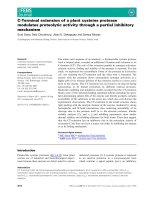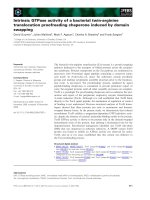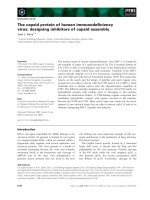báo cáo khoa học: "Skeletal Plasmacytoma: Progression of disease and impact of local treatment; an analysis of SEER database" ppt
Bạn đang xem bản rút gọn của tài liệu. Xem và tải ngay bản đầy đủ của tài liệu tại đây (822.59 KB, 8 trang )
BioMed Central
Page 1 of 8
(page number not for citation purposes)
Journal of Hematology & Oncology
Open Access
Research
Skeletal Plasmacytoma: Progression of disease and impact of local
treatment; an analysis of SEER database
Muhammad Umar Jawad and Sean P Scully*
Address: Departments of Orthopaedics, University of Miami Miller School of Medicine, 1400 NW, 12th Avenue, Miami, FL 33136, USA
Email: Muhammad Umar Jawad - ; Sean P Scully* -
* Corresponding author
Abstract
Background: Previous reports suggest an as yet unidentifiable subset of patients with
plasmacytoma will progress to myeloma. The current study sought to establish the risk of
developing myeloma and determine the prognostic factors affecting the progression of disease.
Methods: Patients with plasmacytoma diagnosed between 1973 and 2005 were identified in the
SEER database(1164 patients). Patient demographics and clinical characteristics, treatment(s), cause
of death, and survival were extracted. Kaplan-Meier, log-rank, and Cox regression were used to
analyze prognostic factors.
Results: The five year survival among patients initially diagnosed with plasmacytoma that later
progressed to multiple myeloma and those initially diagnosed with multiple myeloma were almost
identical (25% and 23%; respectively). Five year survival for patients with plasmacytoma that did not
progress to multiple myeloma was significantly better (72%). Age > 60 years was the only factor
that correlated with progression of disease (p = 0.027).
Discussion: Plasmacytoma consists of two cohorts of patients with different overall survival; those
patients that do not progress to systemic disease and those that develop myeloma. Age > 60 years
is associated with disease progression. Identifying patients with systemic disease early in the
treatment will permit aggressive and novel treatment strategies to be implemented.
Introduction
Plasmacytoma results from clonal proliferation of plasma
cells that are identical to plasma cells of myeloma on both
the cyotologic and immunophenotypic levels. Plasmacy-
toma can be subclassified as osseous disease or extraos-
seous tumor [1-7]. The clinical presentation of these
diseases represent different groups of patients in terms of
location, tumor progression, and overall survival rate [8];
however, they share many of the biologic features of other
plasma cell disorders [1,9]. Skeletal plasmacytoma is char-
acterized clinically by a radiolytic lesion involving any
part of the skeleton, a clonal plasma cell infiltrate and an
absence of disseminated bone marrow involvement.
Local radiotherapy and alternatively surgery are treatment
options yielding adequate local control [7,10]. Despite
local treatment efforts, 50-60% of patients with plasmacy-
toma progresses to myeloma [2,11,12]. It has been
reported that skeletal plasmacytoma is known to progress
more frequently to multiple myeloma than extraskeletal
disease [2,11,13]. Most of the basis for the natural history
of plasmacytoma is derived from reports emanating from
Published: 24 September 2009
Journal of Hematology & Oncology 2009, 2:41 doi:10.1186/1756-8722-2-41
Received: 14 August 2009
Accepted: 24 September 2009
This article is available from: />© 2009 Jawad and Scully; licensee BioMed Central Ltd.
This is an Open Access article distributed under the terms of the Creative Commons Attribution License ( />),
which permits unrestricted use, distribution, and reproduction in any medium, provided the original work is properly cited.
Journal of Hematology & Oncology 2009, 2:41 />Page 2 of 8
(page number not for citation purposes)
single institutions. Knobel et al and Kilciksiz et al reported
multi-center experiences but the small number of patients
limited the statistical power of these studies[10,14].
Recently Dores et al reported incidence and survival for
patients with plasmacytoma, extraskeletal disease and
myeloma from the SEER database [15]. In this study there
was no analysis of prognostic factors associated with nei-
ther progression of cases initially diagnosed as plasmacy-
toma into myeloma nor an assessment of local disease
control.
The current manuscript attempts to ascertain the impact
of local treatment on disease progression in patients with
skeletal plasmacytoma. Specifically, the study sought to
establish the incidence of development of myeloma and
the treatment outcomes of patients initially diagnosed
with plasmacytoma. Furthermore, the study seeks to com-
pare clinical parameters in cases of plasmacytoma not
progressing to systemic disease with those developing into
myeloma to identify prognostic factors. In order to answer
these questions, the SEER Database was utilized as a
source of patient data. Previously the population based
SEER database has been used to describe the outcomes for
breast, colorectal, prostate, lung, ovarian, sarcomas and
neuroectodermal cancers and has been validated as to the
accuracy [16-21]. The current study investigates the
impact of local treatment on skeletal plasmacytoma and
its progression to myeloma and demonstrates that a
younger patient population has localized disease which
does not progress to systemic disease.
Methods
The Surveillance, Epidemiology, and End-Results (SEER)
Program of the National Cancer Institute (NCI) was estab-
lished as a direct result of the National Cancer Act 1971.
Currently SEER collects data from 17 population based
registries covering approximately 26% of the US popula-
tion. It is the only comprehensive source of population
based data in the U.S. that includes the stage of cancer at
the time of diagnosis and follow-up of all patients for sur-
vival data. In addition, each registry collects data on
patient demographics, primary tumor site and morphol-
ogy, and first course of treatment (occurring within 4
months of diagnosis) [22-34]. The SEER program is cur-
rently regarded as the standard of quality among cancer
registries around the world with case completeness of
98% [35].
The SEER database was used to identify all cases of skeletal
plasmacytoma diagnosed from 1973-2005 using Interna-
tional Classification of Disease for Oncology, 3
rd
Edition
(ICD-O-3) [36]. We used primary site of lesion to specifi-
cally select for cases involving bone. A total of 1164
patients were identified and information regarding
patient demographics, clinical characteristics, treatment
related characteristics were extracted (if provided within 4
months of diagnosis), and survival time (months) until
death or loss to follow-up. Percentages were based on
available data for each individual variable. Patients with
missing data were excluded from each respective univari-
ate and multivariate analysis.
Patients' age was converted to a categorical variable (0-29,
30-59, >60) for the purpose of analysis. The appendicular
skeleton included long and short bones of limbs and asso-
ciated joints, and the scapula. Axial skeleton included ver-
tebra, ribs, sternum, clavicle and associated joints, bones
of skull, face and associated joints, mandible, and pelvic
bones. Staging categories of local, regional, and distant
were described in SEER according to AJCC staging system
[37]. Since, skeletal plasmacytoma by definition is a local-
ized disease process we excluded the cases (5.6% of total)
designated as 'distant'. Year of diagnosis was categorized
in four categorical variables: 1973-1975, 1976-1985,
1986-1995, and 1996-2005. Results reported herein are in
compliance with the Health Insurance Portability and
Accountability Act of 1996.
Incidence rates were age adjusted and normalized using
the 2000 US Standard population [38]. Statistical analysis
was performed using SPSS version 17.0 (SPSPSS Inc., Chi-
cago, IL). Chi-square test was used to make correlations
between categorical variables. Overall and disease-specific
survival from the time of initial diagnosis to the date of
last contact (or the date of death) was calculated using the
Kaplan-Meier method. The effects of demographic, clini-
cal, pathological, and treatment variables were tested
using the log-rank test for categorical values. A multivari-
ate analysis was carried out for determination of inde-
pendent prognostic factors using the Cox proportional
hazards model. All prognostic factors found to be signifi-
cant in the univariate analysis, namely gender, stage, pri-
mary site, size, and surgical therapy were included in a
multivariate analysis.
Results
A total of 1164 cases of plasmacytoma are included in the
SEER Data-base from 1973-2005. Nearly three quarter of
the cases (74.7%) were diagnosed during the most recent
decade, 1996-2005 reflecting the geographic expansion of
the data collection effort during these years. The demo-
graphic and clinical characteristics of the entire patient
cohort are summarized in Table 1. Most patients were
older than 60 years at diagnosis (63.7% of the cases).
Males comprised 61.9% of patients; race was predomi-
nantly Caucasian (84.1%) and ethnicity predominantly
non-Hispanic (89.7%), respectively. Among all the cases
identified, 5.2% of the tumors were designated as 'distant'
at the time of diagnosis and thus were excluded from fur-
ther analysis. Staging information was available for 51.4%
Journal of Hematology & Oncology 2009, 2:41 />Page 3 of 8
(page number not for citation purposes)
of the cases that were subjected to analysis. Surgical resec-
tion alone was performed in 34.6% of patients, solely
radiation therapy administered in 53.9%, and combined
surgery and radiation in 0.9%. Approximately 10.5% of
patients received no therapy for local disease control
(dns).
The overall incidence for plasmacytoma was 0.3462/
100,000 in 2005; similar to what has been reported by
Dores et al [15]. Afro-American to Caucasian Incidence
Rates Ratio to develop plasmacytoma was found to be
approximately 1.30 (dns). Five and ten year overall sur-
vival for patients with skeletal plasmacytoma is summa-
rized in Table 2. Kaplan-Meier prediction of survival of
patients with plasmacytoma is affected by race with "races
other than Caucasians" and Afro-Americans faring signif-
icantly better than Caucasians (p < 0.001). Since other
races made up only 4.2% of the entire patient cohort, thus
this result should be interpreted with caution. There was
no significant difference in outcome between Caucasians
and Afro-Americans.
Patients diagnosed at age < 60 years (Figure 1) had a sig-
nificantly better 5 year survival (90% for patients aged 0-
29 years & 80% for patients 30-59 years) when compared
to patients diagnosed at age >60 years (5 year survival
45%) (p < 0.001). Patients with skeletal plasmacytoma
had an overall survival of 57% at 5 years and 37% at 10
years. Females have a significantly lower 5 and 10 year
survival than males (5 year survival 54% v/s 59% for
males (p-value = 0.008). Patients with a solitary lesion
carried significantly better prognosis with a 5 year survival
of 59% as compared to 36% for patients with more than
2 lesions (p = 0.032). There was no significant difference
in survival between patients with a single or two lesions
(p-value = 0.28). There was no significant difference in 5
year survival outcome for axial lesions (58%) as com-
pared to appendicular lesions (52%) (p = 0.24).
Patients undergoing surgery fared no better than patients
without resection (5 year survival 59% and 56% respec-
tively, p = 0.29). In contrast, administration of radiation
therapy was associated with an improvement in survival
(5 year survival of 60% among patients with radiation
therapy as compared to 46% without any radiation ther-
apy, p < 0.001). Further analysis revealed that use of any
local disease control modality, either surgery or radiation
therapy was associated with better outcomes as compared
to the absence of any local disease control (p < 0.001; Fig-
ure 2). Surgery and radiation were found to be equally
effective in local disease control. Use of both modalities
was not associated with any significant survival advan-
tage. No significant improvement in survival could be
observed over time when stratified by decade for the past
two decades (p = 0.19).
Table 3 illustrates a step-wise multivariate analysis
employing the Cox proportional hazard model to ascer-
tain the independent significant variables for the entire
cohort. The parameters age > 60 years (p < 0.001), race
other than Caucasians and Afro-Americans (p < 0.05),
and absence of radiation therapy (p < 0.001) were all
independent predictors of lower overall survival.
In order to compare the plasmacytoma as a localized dis-
ease with cases progressing to myeloma, the survival and
cause of death information were extracted regarding all
the cases of multiple myeloma from 1973-2005 (54,244
cases). We found that there was no significant difference
in 5 year survival among patients initially diagnosed with
multiple myeloma and those initially labeled as plasma-
cytoma who subsequently later progressed to multiple
myeloma (5 year survival of 25% and 23% respectively).
Table 1: Demographic and clinical characteristics of the entire
patient cohort
n Valid % of total
Total Patients 1,164 100
Age
0-29 13 1.1
30-59 410 35.2
>60 741 63.7
Gender
Male 720 61.9
Female 444 38.1
Race
White 973 84.1
Black 135 11.7
Other 49 4.2
Ethnicity
Hispanic 119 10.3
Non-Hispanic 1,035 89.7
Stage
Local 598 100
Lesion
Single 960 82.5
Two 180 15.5
>Two 24 2.1
Location
Bone NOS 15 1.3
Appendicular 187 16.1
Axial 962 82.6
Surgery
Yes 404 34.9
No 752 65.1
Radiation
Yes 927 80.9
No 219 19.1
Year of Diagnosis
1973-1975 2 0.2
1976-1985 27 2.3
1986-1995 265 22.8
1996-2005 870 74.7
Journal of Hematology & Oncology 2009, 2:41 />Page 4 of 8
(page number not for citation purposes)
In contrast, 5 year survival for patients with plasmacy-
toma who did not progress to multiple myeloma was sig-
nificantly better with (p < 0.001 5 year survival = 72%),
Figure 3. Some of the more frequent causes of death in
patients with plasmacytoma not progressing to myeloma
included Diseases of Heart (4.5%) and Cerebrovascular
Diseases (1.0%) as would be expected for patients in this
age group.
Analysis of statistically significant factors on multivariate
analysis did not reveal any prognostic factors significantly
associated with progression of plasmacytoma into a sys-
temic disease other than age (Table 4). Association
between Age >60 years and development of myeloma
approached significance (p = 0.027).
In order to assess the potential ascertainment bias: the
potential bias of falsely diagnosing patients with mye-
loma as plasmacytoma patients, a cross-tabulation was
performed between cause of death and different treatment
groups. Our analysis reveals 27 of 60 patients with no
attempt at local control, died of myeloma. This ratio of
progression to myeloma was similar in other treatment
groups (dns) with chi-square not revealing any statistical
significance.
Discussion
The current study is the first to demonstrate the impact of
local treatment on skeletal plasmacytoma using a popula-
tion based registry. It further demonstrates the differences
in treatment related outcomes among patients diagnosed
Table 2: Disease-specific survival according to demographic and clinical characteristics (proportion surviving)
5-Year Survival 10-Year Survival p-value
Overall 0.57 0.37 n/a
Age
0-29 0.9 0.9
30-59 0.8 0.63
>60 0.45 0.23 <0.001*
Gender
Male 0.59 0.4 0.008
Female 0.54 0.32
Race
White 0.56 0.36
Black 0.56 0.37
Other 0.76 0.64 0.001**
Ethnicity
Hispanic 0.65 0.47 0.152
Non-Hispanic 0.56 0.36
Stage
Local 0.54 0.38 n/a
Lesion
Single 0.59 0.39 0.032***
Two 0.53 0.36
> Two 0.36 0.15
Location
Bone NOS n/a n/a
Appendicular 0.52 0.33
Axial 0.58 0.39 0.240****
Surgery
Yes 0.59 0.4 0.286
No 0.56 0.36
Radiation
Yes 0.6 0.39 <0.001
No 0.46 0.31
Year of Diagnosis
1973-1975 1 1
1976-1985 0.63 0.44
1986-1995 0.52 0.32 0.072*****
1996-2005 0.59 0.42
P value shown for Log rank test between variables; *p < 0.001 for age 0-29 vs. >60 and. 30-59 vs. >60, 30-59 vs. 0-29: p = 0.158; **p = 0.001 for
White vs. Other only, White vs. Black: p = 0.932, and Black vs. Other: p = 0.006; ***p = 0.032 for Single vs. >Two only, Single vs. Two: p = 0.275,
Two vs. > Two only: p = 0.182; ****p = 0.240 for Appendicular vs. Axial only, Bone NOS vs. Appendicular: p < 0.001, Bone NOS vs. Axial: p <
0.001; *****p < 0.072 for 1973-1975 vs. 1986-1995 only, 1973-1975 vs. 1976-1985: p = 0.125, 1973-1975 vs. 1996-2005: p = 0.109, 1976-1985 vs.
1986-1995: p = 0.486, 1976-1985 vs. 1996-2005: p = 0.365, 1986-1995 vs. 1996-2005: p = 0.194.
Journal of Hematology & Oncology 2009, 2:41 />Page 5 of 8
(page number not for citation purposes)
with plasmacytoma not progressing to myeloma, those
that progressed to myeloma. Epidemiological studies
comparing SEER areas to non-SEER areas in the U.S. con-
clude that their age and sex distributions are comparable
except that SEER areas tended to be more affluent and
more urban than non-SEER areas [34]. When compared to
NPCR and USCS, incidence rates for all sites combined
were lower in SEER. But for category of interest: 'Bones
and Joints', the differences were small: 0.6 in SEER versus
0.8 per 100,000 in NPCR among Black males was the larg-
est reported difference [34]. Despite adequate local con-
trol with radiotherapy and/or surgery, cause of death in
59% of the patients initially diagnosed with plasmacy-
toma was progression to myeloma. Similarly, Soutar et al.
reported >75% progression to multiple myeloma for skel-
etal plasmacytoma [12]. In the current study it cannot be
determined that what is the absolute rate of progression to
multiple myeloma among patients diagnosed with plas-
macytoma, since some of the patients died of other causes
and hence are censored. Despite these limitations, we can
confidently say that rate of progression to Multiple Mye-
loma among cases of plasmacytoma is at least 59% and
may be slightly greater than this number.
Also, the 5 year survival for patients diagnosed with mul-
tiple myeloma and those diagnosed as plasmacytoma ini-
tially but who subsequently developed myeloma later on,
were almost identical (Figure 3). This may suggest an
underlying misdiagnosis for cases of myeloma as plasma-
cytoma. In order to overcome this problem, the use of
MRI in initial staging of plasma cell neoplasm has been
advocated by some authors [39] while others have
reported conflicting evidence [14]. We tried to address
this issue by determining any significant association of the
independent predictors of overall survival among patients
with plasmacytoma and subsequent development of mul-
tiple myeloma. None of the factors considered revealed
any significant association with development of mye-
loma, other than age. Age > 60 years was significant with
a p = 0.027 (Table 4). Conflicting evidence for age as a
predictor of progression to myeloma has been reported in
literature, with some studies supporting this observation
[3,40-42] while others have found no association [43-45].
Kilciksiz et al. identified age as an independent prognostic
factor for progression to myeloma [10].
Another controversy highlighted in literature involves the
fate of patients with plasmacytoma in regards to disease
progression. While some have demonstrated a significant
portion of patients free of disease after 5 and 10 years, oth-
ers believe in the inevitability of progression for all
patients [41,43,46,47]. The current study clearly demon-
strates that there is a cohort of plasmacytoma patients that
do not progress to myeloma demonstrate as high as 72%
5-year survival rate (Figure 3).
Overall Survival stratified by AgeFigure 1
Overall Survival stratified by Age.
Overall Survival stratified by Local TreatmentFigure 2
Overall Survival stratified by Local Treatment.
Journal of Hematology & Oncology 2009, 2:41 />Page 6 of 8
(page number not for citation purposes)
Surgery alone has been proposed as the best treatment
option for extramedullary plasmacytomas [48], but con-
flicting evidence has also been provided in the literature
[14]. Uni- and multivariate analysis in the current study
revealed no survival advantage associated with surgery
alone for skeletal plasmacytoma (Table 2). This result
reflects a selection bias: relatively smaller number of
patients underwent surgical resection as a local treatment
option. Radiotherapy was employed for a majority of
cases. Further analysis, after stratification based on local
treatment option clearly demonstrates that use of either
option, i.e. surgical therapy or radiotherapy is associated
with an improvement in survival in skeletal disease. Nei-
ther of the treatment options showed a survival benefit
over the other nor similarly employment of both modali-
ties of local control did not further improve survival.
Limitations of the current study include lack of any infor-
mation on specific chemotherapy regimens or any other
adjuvant therapy in the SEER Database. Thus we are una-
ble to comment directly on survival benefit conferred
upon by the use of chemotherapy or efficacy of a particu-
lar regimen in a particular subset of patients. Similarly, no
information regarding any medical history, radiological
studies or serological work up is provided in the database
limiting our analysis on diagnostic accuracy of MRI, and
prognostic significance of absence of myeloma protein,
anemia, hypercalcemia, renal insufficiency and stability of
M-protein. Accuracy of staging information can be a
potential pitfall in all studies based on database. Another
Table 3: Cox proportional hazards model for risk of death from Ewing's Sarcoma
n Hazard ratio 95% CI p-value
Age
0-29 13 0.075 0.011-0.537 0.01
30-59 401 0.277 0.220-0.349 <0.001
>60 726 Reference Group
Gender
Male 710 0.918 0.764-1.103 0.362
Female 430 Reference Group
Race
White 957 1.893 1.037-3.455 0.038
Black 134 2.080 1.086-3.985 0.027
Other 49 Reference Group
Lesions
Single 939 0.851 0.523-1.387 0.518
Two 177 0.85 0.504-1.434 0.542
> Two 24 Reference Group
Radiation
Yes 925 0.647 0.521-0.804 <0.001
No 215 Reference Group
CI: Confidence Interval
Overall Survival stratified by Disease ProgressionFigure 3
Overall Survival stratified by Disease Progression.
Table 4: Prognostic Factors Associated with Progression
Myeloma Other Causes Chi-Square
Age
0-29 years 0 1 0.027
30-59 years 71 31
60+ years 245 188
Race
White 277 191 0.457
Black 34 22
Others 5 7
Journal of Hematology & Oncology 2009, 2:41 />Page 7 of 8
(page number not for citation purposes)
issue associated with the reported data in SEER is the
potential bias of falsely labeling myeloma patients as plas-
macytoma patients. The results of bone marrow aspirate
are not reported in SEER, and in clinical practice treatment
decisions are usually made based on this parameter. This
raises the suspicion of marrow involvement >30% among
those not receiving the local therapy. Our analysis reveals
no correlation between any treatment groups and 'cause
of death'. We also attempted to address the controversy
regarding progression to myeloma. In clinical practice, the
evaluation regarding progression to myeloma is carried
out after a specified time interval. SEER does not report
the time for evaluation regarding progression; we assessed
the outcome using 'cause of death' information. The time
to progression cannot be assessed.
Conclusion
Despite the above mentioned limitations such as retro-
spective nature of data, lack of information about chemo-
therapy or serological or radiological investigations; the
current study addresses some of the controversies in dis-
ease progression and impact of local treatment for plas-
macytoma using a large populations based well validated
national database. The current study also reiterates the
need of better understanding of the disease process of
plasma cell neoplasm and the inclusion of molecular
markers in the database.
Competing interests
The authors declare that they have no competing interests.
Authors' contributions
MUJ carried out analysis and wrote the manuscript.
SPS conceived the idea and was the senior author in prep-
aration of manuscript.
Both authors have read and approve the manuscript.
References
1. Dimopoulos MA, Hamilos G: Solitary bone plasmacytoma and
extramedullary plasmacytoma. Curr Treat Options Oncol 2002,
3:255-259.
2. Dimopoulos MA, Moulopoulos LA, Maniatis A, Alexanian R: Solitary
plasmacytoma of bone and asymptomatic multiple mye-
loma. Blood 2000, 96:2037-2044.
3. Ozsahin M, Tsang RW, Poortmans P, Belkacemi Y, Bolla M, Dincbas
FO, Landmann C, Castelain B, Buijsen J, Curschmann J, et al.: Out-
comes and patterns of failure in solitary plasmacytoma: a
multicenter Rare Cancer Network study of 258 patients. Int
J Radiat Oncol Biol Phys 2006, 64:210-217.
4. Tong D, Griffin TW, Laramore GE, Kurtz JM, Russell AH, Groudine
MT, Herron T, Blasko JC, Tesh DW: Solitary plasmacytoma of
bone and soft tissues. Radiology 1980, 135:195-198.
5. Galieni P, Cavo M, Avvisati G, Pulsoni A, Falbo R, Bonelli MA, Russo
D, Petrucci MT, Bucalossi A, Tura S: Solitary plasmacytoma of
bone and extramedullary plasmacytoma: two different enti-
ties? Ann Oncol 1995, 6:687-691.
6. Jaffe ES, Harris NL, Stein H, Vardiman JW: World Health Organi-
zation Classification of Tumours: Pathology and Genetics of
Tumours of Hematopoietic and Lymphoid Tissues. IARC
Press, Lyon; 2001.
7. Knowling MA, Harwood AR, Bergsagel DE: Comparison of
extramedullary plasmacytomas with solitary and multiple
plasma cell tumors of bone. J Clin Oncol 1983, 1:255-262.
8. Hussong JW, Perkins SL, Schnitzer B, Hargreaves H, Frizzera G:
Extramedullary plasmacytoma. A form of marginal zone cell
lymphoma? Am J Clin Pathol 1999, 111:111-116.
9. Aalto Y, Nordling S, Kivioja AH, Karaharju E, Elomaa I, Knuutila S:
Among numerous DNA copy number changes, losses of
chromosome 13 are highly recurrent in plasmacytoma.
Genes Chromosomes Cancer 1999, 25:104-107.
10. Kilciksiz S, Celik OK, Pak Y, Demiral AN, Pehlivan M, Orhan O,
Tokatli F, Agaoglu F, Zincircioglu B, Atasoy BM, et al.: Clinical and
prognostic features of plasmacytomas: a multicenter study
of Turkish Oncology Group-Sarcoma Working Party. Am J
Hematol
2008, 83:702-707.
11. Liebross RH, Ha CS, Cox JD, Weber D, Delasalle K, Alexanian R:
Clinical course of solitary extramedullary plasmacytoma.
Radiother Oncol 1999, 52:245-249.
12. Soutar R, Lucraft H, Jackson G, Reece A, Bird J, Low E, Samson D:
Guidelines on the diagnosis and management of solitary
plasmacytoma of bone and solitary extramedullary plasma-
cytoma. Clin Oncol (R Coll Radiol) 2004, 16:405-413.
13. Mayr NA, Wen BC, Hussey DH, Burns CP, Staples JJ, Doornbos JF,
Vigliotti AP: The role of radiation therapy in the treatment of
solitary plasmacytomas. Radiother Oncol 1990, 17:293-303.
14. Knobel D, Zouhair A, Tsang RW, Poortmans P, Belkacemi Y, Bolla M,
Oner FD, Landmann C, Castelain B, Ozsahin M: Prognostic factors
in solitary plasmacytoma of the bone: a multicenter Rare
Cancer Network study. BMC Cancer 2006, 6:118.
15. Dores GM, Landgren O, McGlynn KA, Curtis RE, Linet MS, Devesa
SS: Plasmacytoma of bone, extramedullary plasmacytoma,
and multiple myeloma: incidence and survival in the United
States, 1992-2004. Br J Haematol 2009, 144:86-94.
16. Gutierrez JC, Franceschi D, Koniaris LG: How many lymph nodes
properly stage a periampullary malignancy? J Gastrointest Surg
2008, 12:77-85.
17. Hodgson N, Koniaris LG, Livingstone AS, Franceschi D: Gastric car-
cinoids: a temporal increase with proton pump introduction.
Surg Endosc 2005, 19:1610-1612.
18. Perez EA, Livingstone AS, Franceschi D, Rocha-Lima C, Lee DJ, Hodg-
son N, Jorda M, Koniaris LG: Current incidence and outcomes
of gastrointestinal mesenchymal tumors including gastroin-
testinal stromal tumors. J Am Coll Surg 2006, 202:623-629.
19. Jawad MU, Extein J, Min ES, Scully SP: Prognostic Factors for Sur-
vival in Patients with Epithelioid Sarcoma: 441 Cases from
the SEER Database. Clin Orthop Relat Res 2009 in press.
20. Jawad MU, Cheung MC, Min ES, Schneiderbauer MM, Koniaris LG,
Scully SP: Ewing sarcoma demonstrates racial disparities in
incidence-related and sex-related differences in outcome: an
analysis of 1631 cases from the SEER database, 1973-2005.
Cancer 2009, 115:3526-3536.
21. Giuffrida AY, Burgueno JE, Koniaris LG, Gutierrez JC, Duncan R,
Scully SP: Chondrosarcoma in the United States (1973 to
2003): an analysis of 2890 cases from the SEER database. J
Bone Joint Surg Am 2009, 91:1063-1072.
22. Bach PB, Guadagnoli E, Schrag D, Schussler N, Warren JL: Patient
demographic and socioeconomic characteristics in the
SEER-Medicare database applications and limitations. Med
Care 2002, 40(IV):19-25.
23. Cooper GS, Virnig B, Klabunde CN, Schussler N, Freeman J, Warren
JL: Use of SEER-Medicare data for measuring cancer surgery.
Med Care 2002, 40(IV):43-48.
24. Earle CC, Nattinger AB, Potosky AL, Lang K, Mallick R, Berger M,
Warren JL: Identifying cancer relapse using SEER-Medicare
data. Med Care 2002, 40(IV):75-81.
25. Gloeckler Ries LA, Reichman ME, Lewis DR, Hankey BF, Edwards BK:
Cancer survival and incidence from the Surveillance, Epide-
miology, and End Results (SEER) program. Oncologist 2003,
8:541-552.
26. Hayat MJ, Howlader N, Reichman ME, Edwards BK: Cancer statis-
tics, trends, and multiple primary cancer analyses from the
Surveillance, Epidemiology, and End Results (SEER) Pro-
gram. Oncologist 2007, 12:20-37.
Publish with Bio Med Central and every
scientist can read your work free of charge
"BioMed Central will be the most significant development for
disseminating the results of biomedical research in our lifetime."
Sir Paul Nurse, Cancer Research UK
Your research papers will be:
available free of charge to the entire biomedical community
peer reviewed and published immediately upon acceptance
cited in PubMed and archived on PubMed Central
yours — you keep the copyright
Submit your manuscript here:
/>BioMedcentral
Journal of Hematology & Oncology 2009, 2:41 />Page 8 of 8
(page number not for citation purposes)
27. Merrill RM, Dearden KA: How representative are the surveil-
lance, epidemiology, and end results (SEER) program cancer
data of the United States? Cancer Causes Control 2004,
15:1027-1034.
28. Petrelli NJ: SEER data: it can be thought provoking, but where
do we go from here? Ann Surg Oncol 2007, 14:2173-2174.
29. Potosky AL, Warren JL, Riedel ER, Klabunde CN, Earle CC, Begg CB:
Measuring complications of cancer treatment using the
SEER-Medicare data. Med Care 2002, 40(IV):62-68.
30. Schrag D, Bach PB, Dahlman C, Warren JL: Identifying and meas-
uring hospital characteristics using the SEER-Medicare data
and other claims-based sources. Med Care 2002, 40(IV):96-103.
31. Virnig BA, Warren JL, Cooper GS, Klabunde CN, Schussler N, Free-
man J: Studying radiation therapy using SEER-Medicare-
linked data. Med Care 2002, 40(IV):49-54.
32. Warren JL, Harlan LC, Fahey A, Virnig BA, Freeman JL, Klabunde CN,
Cooper GS, Knopf KB: Utility of the SEER-Medicare data to
identify chemotherapy use. Med Care 2002, 40(IV):55-61.
33. Warren JL, Klabunde CN, Schrag D, Bach PB, Riley GF: Overview of
the SEER-Medicare data: content, research applications, and
generalizability to the United States elderly population. Med
Care 2002, 40(IV):3-18.
34. Wingo PA, Jamison PM, Hiatt RA, Weir HK, Gargiullo PM, Hutton M,
Lee NC, Hall HI: Building the infrastructure for nationwide
cancer surveillance and control a comparison between the
National Program of Cancer Registries (NPCR) and the Sur-
veillance, Epidemiology, and End Results (SEER) Program
(United States). Cancer Causes Control 2003, 14:175-193.
35. NCI: Surveillance, Epidemiology and End Results (SEER)
Program. National Cancer Institute; 2008.
36. IACR: International Classification of Diseases for Oncology.
2000.
37. AJCC Cancer Staging Manual. 2002.
38. Li Y, Yang D, Chen J: [Primary small cell carcinoma of thyroid
with solitary plasmacytoma of the hyoid bone: report of a
case]. Zhonghua Bing Li Xue Za Zhi 2008, 37:351-353.
39. Moulopoulos LA, Dimopoulos MA, Weber D, Fuller L, Libshitz HI,
Alexanian R: Magnetic resonance imaging in the staging of sol-
itary plasmacytoma of bone. J Clin Oncol 1993, 11:1311-1315.
40. Bataille R, Sany J, Serre H: [Apparently isolated plasmacytoma
of bone. Clinical and prognostic data. 114 cases and review
of literature (author's transl)]. Nouv Presse Med 1981,
10:407-411.
41. Frassica DA, Frassica FJ, Schray MF, Sim FH, Kyle RA: Solitary plas-
macytoma of bone: Mayo Clinic experience. Int J Radiat Oncol
Biol Phys 1989, 16:43-48.
42. Tsang RW, Gospodarowicz MK, Pintilie M, Bezjak A, Wells W, Hodg-
son DC, Stewart AK: Solitary plasmacytoma treated with radi-
otherapy: impact of tumor size on outcome. Int J Radiat Oncol
Biol Phys 2001, 50:113-120.
43. Bolek TW, Marcus RB, Mendenhall NP: Solitary plasmacytoma of
bone and soft tissue. Int J Radiat Oncol Biol Phys 1996, 36:329-333.
44. Holland J, Trenkner DA, Wasserman TH, Fineberg B: Plasmacy-
toma. Treatment results and conversion to myeloma. Cancer
1992, 69:1513-1517.
45. Shih LY, Dunn P, Leung WM, Chen WJ, Wang PN: Localised plas-
macytomas in Taiwan: comparison between extramedullary
plasmacytoma and solitary plasmacytoma of bone. Br J Cancer
1995, 71:128-133.
46. Delauche-Cavallier MC, Laredo JD, Wybier M, Bard M, Mazabraud A,
Le Bail Darne JL, Kuntz D, Ryckewaert A: Solitary plasmacytoma
of the spine. Long-term clinical course. Cancer 1988,
61:1707-1714.
47. Wiltshaw E: The natural history of extramedullary plasmacy-
toma and its relation to solitary myeloma of bone and mye-
lomatosis. Medicine (Baltimore) 1976, 55:217-238.
48. Alexiou C, Kau RJ, Dietzfelbinger H, Kremer M, Spiess JC, Schratzen-
staller B, Arnold W: Extramedullary plasmacytoma: tumor
occurrence and therapeutic concepts. Cancer 1999,
85:2305-2314.









